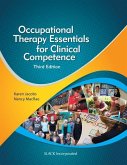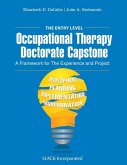Marilyn B. Cole
Group Dynamics in Occupational Therapy
The Theoretical Basis and Practice Application of Group Intervention
Marilyn B. Cole
Group Dynamics in Occupational Therapy
The Theoretical Basis and Practice Application of Group Intervention
- Broschiertes Buch
- Merkliste
- Auf die Merkliste
- Bewerten Bewerten
- Teilen
- Produkt teilen
- Produkterinnerung
- Produkterinnerung
This best-selling textbook, now in its 6th Edition, provides the essential strategies and tools that occupational therapists need to design and organize client groups for enhanced, theory-based therapeutic interventions for physical, mental health and wellness populations.
Andere Kunden interessierten sich auch für
![Occupational Therapy and Women's Health Occupational Therapy and Women's Health]() Sabina KhanOccupational Therapy and Women's Health78,99 €
Sabina KhanOccupational Therapy and Women's Health78,99 €![Assessments in Occupational Therapy Mental Health Assessments in Occupational Therapy Mental Health]() Barbara J. HemphillAssessments in Occupational Therapy Mental Health96,99 €
Barbara J. HemphillAssessments in Occupational Therapy Mental Health96,99 €![Occupational Therapy Essentials for Clinical Competence Occupational Therapy Essentials for Clinical Competence]() Karen JacobsOccupational Therapy Essentials for Clinical Competence183,99 €
Karen JacobsOccupational Therapy Essentials for Clinical Competence183,99 €![Professionalism Across Occupational Therapy Practice Professionalism Across Occupational Therapy Practice]() Elizabeth DeIuliisProfessionalism Across Occupational Therapy Practice72,99 €
Elizabeth DeIuliisProfessionalism Across Occupational Therapy Practice72,99 €![Quick Reference Dictionary for Occupational Therapy Quick Reference Dictionary for Occupational Therapy]() Karen JacobsQuick Reference Dictionary for Occupational Therapy108,99 €
Karen JacobsQuick Reference Dictionary for Occupational Therapy108,99 €![Kinesiology for the Occupational Therapy Assistant Kinesiology for the Occupational Therapy Assistant]() Susan SainKinesiology for the Occupational Therapy Assistant109,99 €
Susan SainKinesiology for the Occupational Therapy Assistant109,99 €![The Entry Level Occupational Therapy Doctorate Capstone The Entry Level Occupational Therapy Doctorate Capstone]() Elizabeth DeIuliisThe Entry Level Occupational Therapy Doctorate Capstone132,99 €
Elizabeth DeIuliisThe Entry Level Occupational Therapy Doctorate Capstone132,99 €-
-
-
This best-selling textbook, now in its 6th Edition, provides the essential strategies and tools that occupational therapists need to design and organize client groups for enhanced, theory-based therapeutic interventions for physical, mental health and wellness populations.
Produktdetails
- Produktdetails
- Verlag: SLACK Incorporated
- 6 ed
- Seitenzahl: 496
- Erscheinungstermin: 25. Februar 2025
- Englisch
- Abmessung: 280mm x 210mm x 27mm
- Gewicht: 1170g
- ISBN-13: 9781638221524
- ISBN-10: 1638221529
- Artikelnr.: 70974956
- Herstellerkennzeichnung
- Libri GmbH
- Europaallee 1
- 36244 Bad Hersfeld
- gpsr@libri.de
- Verlag: SLACK Incorporated
- 6 ed
- Seitenzahl: 496
- Erscheinungstermin: 25. Februar 2025
- Englisch
- Abmessung: 280mm x 210mm x 27mm
- Gewicht: 1170g
- ISBN-13: 9781638221524
- ISBN-10: 1638221529
- Artikelnr.: 70974956
- Herstellerkennzeichnung
- Libri GmbH
- Europaallee 1
- 36244 Bad Hersfeld
- gpsr@libri.de
Marilyn B. Cole, MS, OTR/L, FAOTA, is a Professor Emerita of Occupational Therapy at Quinnipiac University, Hamden, CT, and an occupational therapy (OT) consultant and writer. After 25 years of full-time teaching, she has now become a full-time writer. She holds a bachelors degree in English from the University of Connecticut, a graduate certificate of occupational therapy from the University of Pennsylvania, and a master of science in clinical psychology from the University of Bridgeport. She is licensed in OT by the State of Connecticut, and certified by the National Board of OT (NBCOT). The author has 24 years of practice experience in mental health, pediatrics, and geriatrics.
About the Author
Introduction to the Sixth Edition
Section I: Acquiring Group Skills
1 Group Leadership: Cole's Seven Steps
2 Understanding Group Dynamics
3 Client-Centered Groups
4 Groups in the context of DEI and the OT Framework 4th Ed. Section II: Group Guidelines from OT Models & Frames of Reference
Chapter 5: Psychodynamic Approaches 6: The Behavioral-Cognitive Continuum
7: Allen's Cognitive Disabilities Groups
8: Developmental Approaches
9: Sensory Motor Approaches
10: A Model of Human Occupation & Other Occupation-Based Models
Section III: Planning an Occupational Therapy Group
11: Writing a Group Protocol and the Quinnipiac Model
12: An Introductory Laboratory Experience for Students Group Protocol: Developing Your Professional Self
13: A Diversity
Equity
and Inclusion Group Experience Group Protocol: Seeing Myself: My Uniqueness in the Contest of my Culture.
14: Community Groups: Service-Learning Experiences for Students
15: Wellness
Recovery and Trauma Informed Care Appendix A: The Task-Oriented Group as a Context for Treatment Appendix B: The Concept and Use of Developmental Groups Appendix C: Summary of the AOTA Ethical Code Appendix D: Excerpts from the OT Practice Framework
4th Ed. Appendix E: Comparison of Group Leadership Guidelines in OT Models & Frames of Reference Appendix F: Overview of International Classification of Function (ICF)
Introduction to the Sixth Edition
Section I: Acquiring Group Skills
1 Group Leadership: Cole's Seven Steps
2 Understanding Group Dynamics
3 Client-Centered Groups
4 Groups in the context of DEI and the OT Framework 4th Ed. Section II: Group Guidelines from OT Models & Frames of Reference
Chapter 5: Psychodynamic Approaches 6: The Behavioral-Cognitive Continuum
7: Allen's Cognitive Disabilities Groups
8: Developmental Approaches
9: Sensory Motor Approaches
10: A Model of Human Occupation & Other Occupation-Based Models
Section III: Planning an Occupational Therapy Group
11: Writing a Group Protocol and the Quinnipiac Model
12: An Introductory Laboratory Experience for Students Group Protocol: Developing Your Professional Self
13: A Diversity
Equity
and Inclusion Group Experience Group Protocol: Seeing Myself: My Uniqueness in the Contest of my Culture.
14: Community Groups: Service-Learning Experiences for Students
15: Wellness
Recovery and Trauma Informed Care Appendix A: The Task-Oriented Group as a Context for Treatment Appendix B: The Concept and Use of Developmental Groups Appendix C: Summary of the AOTA Ethical Code Appendix D: Excerpts from the OT Practice Framework
4th Ed. Appendix E: Comparison of Group Leadership Guidelines in OT Models & Frames of Reference Appendix F: Overview of International Classification of Function (ICF)
About the Author
Introduction to the Sixth Edition
Section I: Acquiring Group Skills
1 Group Leadership: Cole's Seven Steps
2 Understanding Group Dynamics
3 Client-Centered Groups
4 Groups in the context of DEI and the OT Framework 4th Ed. Section II: Group Guidelines from OT Models & Frames of Reference
Chapter 5: Psychodynamic Approaches 6: The Behavioral-Cognitive Continuum
7: Allen's Cognitive Disabilities Groups
8: Developmental Approaches
9: Sensory Motor Approaches
10: A Model of Human Occupation & Other Occupation-Based Models
Section III: Planning an Occupational Therapy Group
11: Writing a Group Protocol and the Quinnipiac Model
12: An Introductory Laboratory Experience for Students Group Protocol: Developing Your Professional Self
13: A Diversity
Equity
and Inclusion Group Experience Group Protocol: Seeing Myself: My Uniqueness in the Contest of my Culture.
14: Community Groups: Service-Learning Experiences for Students
15: Wellness
Recovery and Trauma Informed Care Appendix A: The Task-Oriented Group as a Context for Treatment Appendix B: The Concept and Use of Developmental Groups Appendix C: Summary of the AOTA Ethical Code Appendix D: Excerpts from the OT Practice Framework
4th Ed. Appendix E: Comparison of Group Leadership Guidelines in OT Models & Frames of Reference Appendix F: Overview of International Classification of Function (ICF)
Introduction to the Sixth Edition
Section I: Acquiring Group Skills
1 Group Leadership: Cole's Seven Steps
2 Understanding Group Dynamics
3 Client-Centered Groups
4 Groups in the context of DEI and the OT Framework 4th Ed. Section II: Group Guidelines from OT Models & Frames of Reference
Chapter 5: Psychodynamic Approaches 6: The Behavioral-Cognitive Continuum
7: Allen's Cognitive Disabilities Groups
8: Developmental Approaches
9: Sensory Motor Approaches
10: A Model of Human Occupation & Other Occupation-Based Models
Section III: Planning an Occupational Therapy Group
11: Writing a Group Protocol and the Quinnipiac Model
12: An Introductory Laboratory Experience for Students Group Protocol: Developing Your Professional Self
13: A Diversity
Equity
and Inclusion Group Experience Group Protocol: Seeing Myself: My Uniqueness in the Contest of my Culture.
14: Community Groups: Service-Learning Experiences for Students
15: Wellness
Recovery and Trauma Informed Care Appendix A: The Task-Oriented Group as a Context for Treatment Appendix B: The Concept and Use of Developmental Groups Appendix C: Summary of the AOTA Ethical Code Appendix D: Excerpts from the OT Practice Framework
4th Ed. Appendix E: Comparison of Group Leadership Guidelines in OT Models & Frames of Reference Appendix F: Overview of International Classification of Function (ICF)









